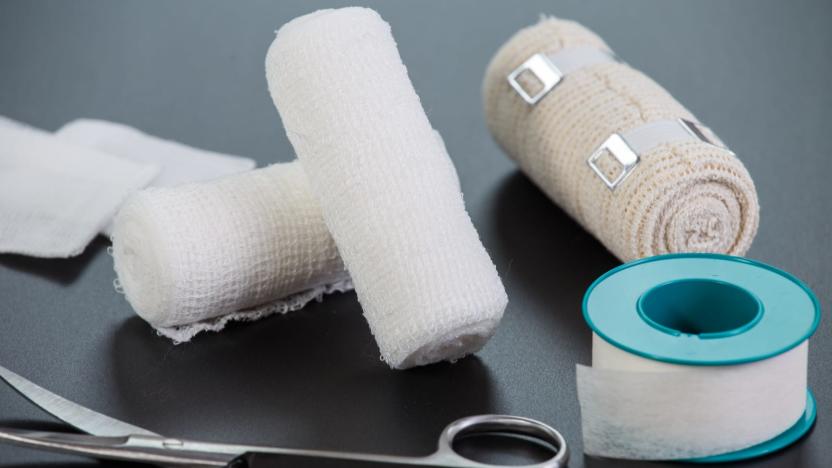wounds
Latest

Color-changing bandages detect and treat drug-resistant infections
It may sound dramatic, but antibiotic resistance is one of the biggest threats to global health. According to the World Health Organization (WHO), it's urgent that we change the way we prescribe and use antibiotics. One approach might be to use bandages that sense and treat bacterial infections, even when the pathogen shows resistance. In a paper published by ACS Central Science, researchers from the Chinese Academy of Science explain how they've developed a way to do just that.

Virtual wound will teach medics how to treat soldiers
Field medics have ways to practice their craft before they're helping soldiers on the battlefield, but it's hard for them to understand how wounds work until they're involved in a life-or-death rescue. UCLA scientists may have the tool these medics need, however: they've developed the first detailed injury simulation to show medics what to expect. The virtual gash could make you a bit queasy (sorry!), but it's uncannily accurate. A mix of fluid dynamics and in-depth mechanics (such as bones, skin and vessels) makes sure that blood flows much as it would from a real person.

Fizzy microparticles may save lives on the battlefield
Battlefield medics and paramedics rely on chemical-infused bandages to help stem blood loss and treat wounds. However, the blood itself is frequently their worst enemy -- it takes those chemicals away from where they're needed. Those first responders may soon have a much smarter solution, though. Researchers have developed bandages with a combination of powdered marble, acid and enzymes that fizzes on contact with blood, using the resulting bubbles to transport microparticles toward deeper vessels that need clotting. The particles currently travel in all directions, but scientists envision using an endoscope to send the fizz to where it's most useful.

MIT and US Army crafting uniforms with full-body fiberoptic sensors
Militaries want soldiers to carry an increasing amount of tech on to the battlefield, but that isn't necessarily convenient -- or comfortable. MIT and the US Army have started early work on uniforms with fiberoptic sensors that would alleviate much of that burden. By weaving in microfibers cut from a mix of specialized, fluidized materials, the partnership can build data links that cover the entire body without breaking or adding significant bulk. They could serve as basic elements of a communication system, but MIT has broader ambitions: the sensors could track wounds through heat signatures, and just might prevent friendly fire incidents by sending a don't-shoot signal when targeted with a laser sight. The fibers still have to get much thinner before the Army can offer smart uniforms as standard issue, but the wearable tech may keep soldiers nimble and, just possibly, save a few lives.

Waging WAR: Guide to defensive stats
Greg takes us through to see the dark side of our character sheets, and explains the various defensive stats found in Warhammer Online: Age of Reckoning. He trudges through this week's Waging WAR with the stubborn stoutness of an Ironbreaker, and the cunning pre-determination of Tzeentch's Chosen to bring us this guide... For every 10 tanks running around with gigantic two-handed weapons and the Focused Offense tactic slotted, there is one tank with a shield. And for every 10 of those tanks, there's that one who will step onto the battlefield and shake its very foundations with his/her ability to soak incredible amounts of damage and survive. What makes those tanks so indomitable? It is their preference for and understanding of defensive statistics. Sure, they may not hit as hard as others, but their ability to stand defiantly in the face of an entire warband is what makes them so fearsome. With confidence, these rare titans stride onto the battlefields knowing they could put up a fight against death itself and stand a chance to win. Continue after the break as I explain the defensive character statistics of WAR.

DARPA longs for magnetic body healers, crazy respawn camps
Even DARPA understands that its futuristic bubble shield can be penetrated given the right circumstances, and when it does, the soldier behind it is going to need some serious healing. In a hurry. In the entity's newest budget, there's $6.5 million tucked away "for the creation of a scaffold-free tissue engineering platform, which would allow the construction of large, complex tissues in vitro and in vivo." As you well know, this type of mad science has been around for quite some time, and now it looks as if DARPA is ready for the next best thing: "non-contact forces." Put simply, this alludes to replacing scaffolds with magnetic fields or dielectrophoresis, which could purportedly "control cell placement in a desired pattern for a sufficient period of time to allow the cells to synthesize their own scaffold." It's still too early to say how close we are to being able to instantaneously heal soldiers on the battlefield, but frankly, the public is apt to never know for sure.

Electric bandages: not your favorite new prog-rock band
Finally, a use for electrocution besides your own, twisted interests. A company in Arizona has created a bandaging system which uses electrically activated wound-dressings to heal injuries. Dubbed the CMB Antimicrobial Wound Dressing with PROSIT (or CMBAWDWP as we like to call it), the bandage works by utilizing a single-layer polyester fabric which can carry a low-level electrical charge when wet. Over a short period of time, the charge can greatly reduce bacteria and infections in the treatment area. Also, it's fun at parties.[Via medgadget]


